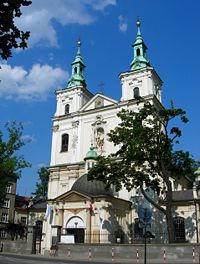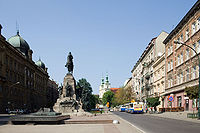
St. Florian's Church
Encyclopedia


Kraków
Kraków also Krakow, or Cracow , is the second largest and one of the oldest cities in Poland. Situated on the Vistula River in the Lesser Poland region, the city dates back to the 7th century. Kraków has traditionally been one of the leading centres of Polish academic, cultural, and artistic life...
, Poland
Poland
Poland , officially the Republic of Poland , is a country in Central Europe bordered by Germany to the west; the Czech Republic and Slovakia to the south; Ukraine, Belarus and Lithuania to the east; and the Baltic Sea and Kaliningrad Oblast, a Russian exclave, to the north...
. It stands at the northern end of Matejko
Jan Matejko
Jan Matejko was a Polish painter known for paintings of notable historical Polish political and military events. His most famous works include oil on canvas paintings like Battle of Grunwald, paintings of numerous other battles and court scenes, and a gallery of Polish kings...
Square and the former centre of the mediaeval city of Kleparz, now a district of Kraków. The edifice marks the beginning of the Royal Road
Royal Road, Kraków
The Royal Road or Royal Route in Kraków, Poland, begins at the northern end of the medieval Old Town and continues south through the centre of town towards Wawel Hill, where the old royal residence, Wawel Castle, is located...
.
St. Florian's Church was built between 1185 and 1216. It was consumed by fire many times in the 12th, 16th and 17th centuries. Notably, during the Swedish siege of Kraków, General Stefan Czarniecki
Stefan Czarniecki
Stefan Czarniecki or Stefan Łodzia de Czarnca Czarniecki Polish-Lithuanian Commonwealth general and nobleman. Field Hetman of the Crown of the Polish Kingdom. He was a military commander, regarded as a Polish national hero...
ordered the city's suburbs burned down. However, during the city-wide fire which consumed a considerable part of Kraków in 1528, the church – containing St. Florian's relics – was miraculously saved. Since then St. Florian, usually portrayed as a Roman legion
Roman legion
A Roman legion normally indicates the basic ancient Roman army unit recruited specifically from Roman citizens. The organization of legions varied greatly over time but they were typically composed of perhaps 5,000 soldiers, divided into maniples and later into "cohorts"...
officer carrying water, has been revered in Poland as patron saint
Patron saint
A patron saint is a saint who is regarded as the intercessor and advocate in heaven of a nation, place, craft, activity, class, clan, family, or person...
of firefighters and chimneysweeps. The church's present appearance is the result of a Baroque
Baroque architecture
Baroque architecture is a term used to describe the building style of the Baroque era, begun in late sixteenth century Italy, that took the Roman vocabulary of Renaissance architecture and used it in a new rhetorical and theatrical fashion, often to express the triumph of the Catholic Church and...
renovation that followed the Polish-Swedish wars
Polish-Swedish wars
The Polish–Swedish Wars were a series of wars between the Polish–Lithuanian Commonwealth and Sweden. Broadly construed, the term refers to a series of wars between 1563 and 1721. More narrowly, it refers two particular wars between 1600 and 1629...
.
Since the 16th century the Church has been the University Collegiate
Collegiate church
In Christianity, a collegiate church is a church where the daily office of worship is maintained by a college of canons; a non-monastic, or "secular" community of clergy, organised as a self-governing corporate body, which may be presided over by a dean or provost...
. The coronation route began there, with the rector
Rector
The word rector has a number of different meanings; it is widely used to refer to an academic, religious or political administrator...
of the university senate welcoming new kings. The Church was also the starting point for royal funeral processions to Wawel Cathedral
Wawel Cathedral
The Wawel Cathedral, also known as the Cathedral Basilica of Sts. Stanisław and Vaclav, is a church located on Wawel Hill in Kraków–Poland's national sanctuary. It has a 1,000-year history and was the traditional coronation site of Polish monarchs. It is the Cathedral of the Archdiocese of Kraków...
.
In 1667 the remains of Queen Ludwika Maria Gonzaga
Ludwika Maria Gonzaga
Marie Louise Gonzaga was queen consort to two Polish kings: Władysław IV Vasa, and John II Casimir Vasa...
, wife of King Jan II Kazimierz, were placed there temporarily, and in 1818 the remains of Tadeusz Kościuszko
Tadeusz Kosciuszko
Andrzej Tadeusz Bonawentura Kościuszko was a Polish–Lithuanian and American general and military leader during the Kościuszko Uprising. He is a national hero of Poland, Lithuania, the United States and Belarus...
were put there to rest. From 17 September 1949 till September 1951, the future Blessed Pope John Paul II, then Father Karol Wojtyła, worked there as a vicar
Vicar
In the broadest sense, a vicar is a representative, deputy or substitute; anyone acting "in the person of" or agent for a superior . In this sense, the title is comparable to lieutenant...
; in 1999 he elevated the Church to a minor basilica
Minor basilica
Minor basilica is a title given to some Roman Catholic churches. By canon law no Catholic church can be honoured with the title of basilica unless by apostolic grant or from immemorial custom....
. He also visited the Church on his papal pilgrimage to Poland on 18 September 2002.
The legend
Legend has it that in 1184 oxen carrying the remains of St. Florian – the future patron saint of Poland – came to a halt at a place where the Church now stands. The relics miraculously grew too heavy to be taken any further into the city and remained in Kleparz until it was decided for the Church to be built at that exact spot. The martyr had had nothing do with Poland before his relics were brought from RomeRome
Rome is the capital of Italy and the country's largest and most populated city and comune, with over 2.7 million residents in . The city is located in the central-western portion of the Italian Peninsula, on the Tiber River within the Lazio region of Italy.Rome's history spans two and a half...
to Kraków. Kraków needed a saint for political reasons, in order to reaffirm its role as Poland's capital, which was contested by the city of Gniezno
Gniezno
Gniezno is a city in central-western Poland, some 50 km east of Poznań, inhabited by about 70,000 people. One of the Piasts' chief cities, it was mentioned by 10th century A.D. sources as the capital of Piast Poland however the first capital of Piast realm was most likely Giecz built around...
.
The district of Kleparz was founded by Casimir the Great in 1366 as a separate town, around St. Florian's Church. It was named by King Casimir as Florencja (Florence) after its centrally located church, or in Latin, Clepardia. Kleparz remained an unofficial suburb of Kraków till 1792, when the Polish Parliament incorporated it within the city.
Selected reference
- St. Florian's Church at travel.yahoo.com
- St. Florian's Church at krakow4u.pl
- Kleparz at what-where-when.pl
- Story of St. Florian's relics (Polish language only)
See also
- Collegiate Church of St. Florian at wikitravel.org
- Catholic Online article about St. Florian
- St. Florian's Gate
- St. Florian's CathedralSt. Florian's CathedralSt. Florian's Cathedral, more formally known as the Cathedral of St. Michael the Archangel and St. Florian the Martyr , is a Catholic church and historical landmark at ul. Floriańska 3 in eastern Warsaw. The 75-meter towers of St...
, WarsawWarsawWarsaw is the capital and largest city of Poland. It is located on the Vistula River, roughly from the Baltic Sea and from the Carpathian Mountains. Its population in 2010 was estimated at 1,716,855 residents with a greater metropolitan area of 2,631,902 residents, making Warsaw the 10th most...

